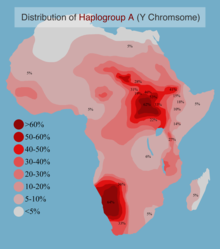| Haplogroup A | |
|---|---|
 | |
| Possible time of origin | 270,000 BP,[1][2] 275,000 BP (303,000-241,000 BP),[3][4] 291,000 BP[5] |
| Coalescence age | 275,000 BP (split with other lineages)[6] |
| Possible place of origin | Northwest Africa, Central Africa[7] |
| Ancestor | Human Y-MRCA (A00-T) |
| Descendants | primary: A00 (AF6/L1284), A0-T (Subclades of these include haplogroups A00a, A00b, A00c, A0, A1, A1a, A1b, A1b1 and BT.) |
Haplogroup A is a human Y-chromosome DNA haplogroup, which includes all living human Y chromosomes. Bearers of extant sub-clades of haplogroup A are almost exclusively found in Africa (or among the African diaspora), in contrast with haplogroup BT, bearers of which participated in the Out of Africa migration of early modern humans. The known branches of haplogroup A are A00, A0, A1a, and A1b1; these branches are only very distantly related, and are not more closely related to each other than they are to haplogroup BT.
- ^ equivalent to an estimate of the age of the human Y-MRCA (see there); including the A00 lineage, Karmin et al. (2015) and Trombetta et al. (2015) estimate ages of 254,000 and 291,000 ybp, respectively.
- ^ Karmin; et al. (2015). "A recent bottleneck of Y chromosome diversity coincides with a global change in culture". Genome Research. 25 (4): 459–66. doi:10.1101/gr.186684.114. PMC 4381518. PMID 25770088. "we date the Y-chromosomal most recent common ancestor (MRCA) in Africa at 254 (95% CI 192–307) kya and detect a cluster of major non-African founder haplogroups in a narrow time interval at 47–52 kya, consistent with a rapid initial colonization model of Eurasia and Oceania after the out-of-Africa bottleneck. In contrast to demographic reconstructions based on mtDNA, we infer a second strong bottleneck in Y-chromosome lineages dating to the last 10 ky. We hypothesize that this bottleneck is caused by cultural changes affecting variance of reproductive success among males."
- ^ Mendez, L.; et al. (2016). "The Divergence of Neandertal and Modern Human Y Chromosomes". The American Journal of Human Genetics. 98 (4): 728–34. doi:10.1016/j.ajhg.2016.02.023. PMC 4833433. PMID 27058445.
- ^ Lipson, Mark; Ribot, Isabelle; Mallick, Swapan; Rohland, Nadin; Olalde, Iñigo; Adamski, Nicole; Broomandkhoshbacht, Nasreen; Lawson, Ann Marie; López, Saioa; Oppenheimer, Jonas; Stewardson, Kristin; Asombang, Raymond Neba’ane; Bocherens, Hervé; Bradman, Neil; Culleton, Brendan J.; Cornelissen, Els; Crevecoeur, Isabelle; de Maret, Pierre; Fomine, Forka Leypey Mathew; Lavachery, Philippe; Mindzie, Christophe Mbida; Orban, Rosine; Sawchuk, Elizabeth; Semal, Patrick; Thomas, Mark G.; Van Neer, Wim; Veeramah, Krishna R.; Kennett, Douglas J.; Patterson, Nick; Hellenthal, Garrett; Lalueza-Fox, Carles; MacEachern, Scott; Prendergast, Mary E.; Reich, David (30 January 2020). "Ancient West African foragers in the context of African population history". Nature. 577 (7792): 665–670. Bibcode:2020Natur.577..665L. doi:10.1038/s41586-020-1929-1. PMC 8386425. PMID 31969706.
- ^ Trombetta, Beniamino; d'Atanasio, Eugenia; Massaia, Andrea; Myres, Natalie M.; Scozzari, Rosaria; Cruciani, Fulvio; Novelletto, Andrea (2015). "Regional Differences in the Accumulation of SNPs on the Male-Specific Portion of the Human Y Chromosome Replicate Autosomal Patterns: Implications for Genetic Dating". PLOS ONE. 10 (7): e0134646. Bibcode:2015PLoSO..1034646T. doi:10.1371/journal.pone.0134646. PMC 4520482. PMID 26226630.
- ^ "A00 YTree".
- ^ According to Cruciani et al. 2011, the most basal lineages have been detected in West, Northwest and Central Africa, suggesting plausibility for the Y-MRCA living in the general region of North-Central Africa". In a sample of 2204 African Y-chromosomes, 8 chromosomes belonged to either haplogroup A1b or A1a. Haplogroup A1a was identified in two Moroccan Berbers, one Fulbe and one Tuareg people from Niger. Haplogroup A1b was identified in three Bakola pygmies from Southern Cameroon and one Algerian Berber. Cruciani, Fulvio; Trombetta, Beniamino; Massaia, Andrea; Destro-Bisol, Giovanni; Sellitto, Daniele; Scozzari, Rosaria (2011). "A Revised Root for the Human Y Chromosomal Phylogenetic Tree: The Origin of Patrilineal Diversity in Africa". The American Journal of Human Genetics. 88 (6): 814–8. doi:10.1016/j.ajhg.2011.05.002. PMC 3113241. PMID 21601174. Scozzari et al. (2012) agreed with a plausible placement in "the north-western quadrant of the African continent" for the emergence of the A1b haplogroup: "the hypothesis of an origin in the north-western quadrant of the African continent for the A1b haplogroup, and, together with recent findings of ancient Y-lineages in central-western Africa, provide new evidence regarding the geographical origin of human MSY diversity". Scozzari R; Massaia A; D'Atanasio E; Myres NM; Perego UA; et al. (2012). Caramelli, David (ed.). "Molecular Dissection of the Basal Clades in the Human Y Chromosome Phylogenetic Tree". PLOS ONE. 7 (11): e49170. Bibcode:2012PLoSO...749170S. doi:10.1371/journal.pone.0049170. PMC 3492319. PMID 23145109.